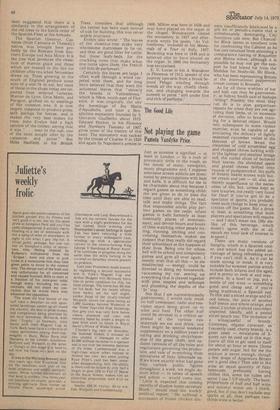Gardening
Chestnuts in blossom
Denis Wood
Spanish chestnuts have their catkin flowers in July, yellowishgreen feathery plumes, a fine sight at high summer. They are sturdy, masculine trees of the largest size, capable of reaching to a hundred feet, of unusually stout girth, and having a branch spread of about 60ft. In maturity their trunks become deeply furrowed, usually in ascending spiral grooves. They are good trees for parks but a little robust for all but the largest of gardens; excellent standing alone, or as at Croft Castle planted as an avenue.
Croft is a National Trust Property, five miles from Leominster in Herefordshire When 1 was there last summer I got hold of a pamphlet, Hortus Croftensis, which is informative on this avenue. There is a story that the chestnuts were raised from nuts washed ashore from ships of the Armada, and another that the avenue was planted by Bishop Croft to celebrate the restoration of Charles II in 1660. It has also
• been suggested that there is a similarity in the arrangement of the old trees to the battle order of the Spanish Fleet at the Armada.
The Spanish chestnut, Castanea (from Castania in Thessaly) sativa, was brought here probably by the Romans from Southern Europe and Asia Minor. It is the tree that produces the chestnuts of marron glace and those which are roasted in the fire for. . children after tea when November draws on. Trees growing in the south of England produce some nuts of a size fit to eat, but most of those in the shops today are imported from selected varieties, Marron de Lyon, Gros Merle, and Paragon, grafted on to seedlings of the common tree. It is now largely coppicecl to produce poles, split palings for fences, and it makes the very best stakes for trees, John Evelyn had a high opinion of the timber, saying that it was " . next to the oak, one of the most sought after by the carpenter and joiner." But Miles Hadfield, in his British
Trees, considers that although the timber has been used instead of oak for building, this was never widely practised. Evelyn also wrote: "The leaves of the chestnut-tree make very wholesome mattresses to lie on, and they are good litter for cattle: but those leafy-beds, for the crackling noise they make when one turns upon them, the French call licts de parlement."
Certainly the leaves are large. I often walk through a wood carpeted with them, and for long have believed that they were the autumnal leaves that " strow'd the brooks in Vallombrosa," which is 34km. south-east of Florence. It was originally the site' the hermitage of Sta Maria d'Aquabella, and later a Benedictine monastery founded by S. Giovanni Gualberto about 1015. Edward Hutton, in his Florence and Northern Tuscany of 1907, gives some of the history of this saint. The monastery was sacked by the troops of Charles V in 1529 and again by Napoleon's armies in
1808. Milton was here in 1638 and may have played on the organ in the chapel. Wordsworth visited the monastery in 1837 and afterwards wrote his poem, ' At Vallombrosa,' included in his Memo, rials of a Tour in Italy, 1837. Browning was here in 1848 and is believed also to' have 'played on the organ. In 1866 the rrionastery was secularised.
E. V. Lucas in his A Wanderer in Florence, of 1912, speaks of the journey upwards from a brook beyond Pelago winding through woods all the way, chiefly chestnut, and changing towards the summit to pines " soft under foot and rich of perfume."































 Previous page
Previous page